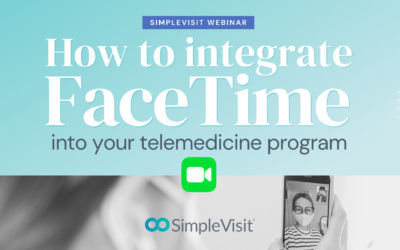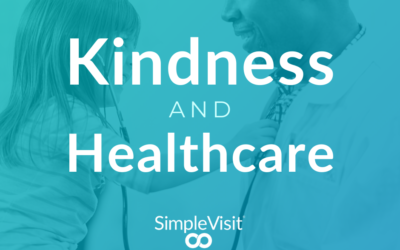
Are Providers Saving Time with Video Visits?
Time is money, and nowhere is this more true than in the world of healthcare. One of the early advantages of using telemedicine is time savings. Both patients and providers are utilizing video visits to be more effective with their visits and save time in their day. This is because when compared head-to-head with patients who have the same needs, video proves to be faster than the in-person equivalent. Video visits are proven to improve the efficiency with which a practice operates and reduces the time spent with patients without sacrificing quality of care. This form of telemedicine is effective in saving time because it combines charting with patient analysis, reduce late and missed visits, focus on information exchange and improve provider and patient availability.

The average time a physician spends with a patient in America is 17.4 minutes. While many providers feel pressure to increasingly reduce visit times, providers are also challenged to balance patient satisfaction and quality of care with a sense of urgency to move patients through the process faster. Telemedicine is helping providers with this challenge, to become more time efficient without sacrificing quality of care or patient satisfaction.
On average, telemedicine providers are seeing a reduction on visit times by about 20%, with the average visit time in one study being as low as 12 minutes. While this may not seem like a significant improvement, upon further exploration, the implications are far more reaching. Let’s assume under the current model an efficient provider can process 28 patients a day, which represents 4 patients an hour for 7 hours. Now let’s assume that conservatively under telemedicine, a provider can see an additional 4 patients a day over video visits, with an average charge of $60 per visit. Over the course of a year, this process would net the provider an additional $62,000 in practice revenue. One study found that a practice was able to save its patients nearly $3 million in travel costs over the nine years it had been offering telemedicine, the average patient saving 4 hours per year in travel time. With financial benefits available to both patients and providers, it is no wonder why the transition to telemedicine is in such high demand.
While these numbers seem to paint a positive picture, it is important to evaluate how this reduction in visit times is actually occurring. Video visits allow providers to work more efficiently with patients by combining a provider’s ability to chart the visit while streaming a live video session, which enables the doctor’s attention to remain on the screen. In addition, video visits are usually restricted to follow up or acute conditions that tend to have lower visit times. Nevertheless, there are several other factors to explain why this time reduction may be occurring…
Minimize Missed Appointments
Due to the convenience of video visits, patients will miss fewer appointments and are more likely to show up for their visits on time. Missed visits cause lost income and productivity for providers and the practice, and late arrivals may cause providers to run behind, thus delaying other patient visits.
Maximize Session Time
Another reason providers are seeing time savings is the focus on information exchange that occurs during video visits. Telemedicine visits tend to be much more focused than in-person visits, as the spectrum of care providers can provide is limited to what they can only do remotely. Telemedicine visits are often focused around screening or maintenance of the patient, allowing the provider to focus on next steps rather than troubleshooting solutions during a visit.
Expand Availablity
Lastly, providers are able to offer expanded hours of availability when providing video visits. Whether it is seeing patients during their lunch hour or late from home on Wednesdays, with telemedicine providers have more flexibility to see patients due to the reduced barriers surrounding patient and provider location. This flexibility nets significant savings when a patient who had to cancel is suddenly able to attend their normally scheduled visit time or simply move their visit to an after-hour time via the power of video.
A doctor’s time is invaluable, and the crisis of time is no longer an expense we can afford to waste on administrative duties or inefficient patient visits. Equally, a patient’s time should not be overlooked, as the transition to urgent care shows a growing consumer demand for on-demand care. By improving the efficiency of a visit for patient and provider, we can transition to a system of care which is more patient-centered and empowers physicians to focus on treatment and diagnosis. The televisit is enabling visits to occur faster than ever before, and as a result, will produce a more efficient and effective healthcare system.
About SimpleVisit
SimpleVisit is a video service which allows patients and providers to connect over the video platform of their choice. With SimpleVisit providers are able to deliver on-demand visits to patients over any device or platform they have available to them. For more information on SimpleVisit and on how we are enabling providers to host virtual visits check out www.SimpleVisit.com
How to Integrate FaceTime for Telemedicine
Rob Warlick | 3 min read | April 23, 2021During the public health emergency, direct FaceTime calls are permitted for healthcare. Outside of that waiver, SimpleVisit is the only HIPAA-compliant way to bridge in FaceTime and other video calling apps. With over 620...
Using FaceTime for Telemedicine in 2021
Rob Warlick | 4 min read | January 26, 2021 In response to the global pandemic and the public health emergency, many medical groups have purchased or crafted a solution to treat over video. Due to the lax in federal regulations, many are turning to commonly available...
Kindness and Healthcare
Allie Clark | 10 min read | December 2, 2020It is time for some kindness. The holiday season can be a rough time for many among us. A report from the National Alliance on Mental Illness shows that this time of the year negatively affects a majority of people suffering...



